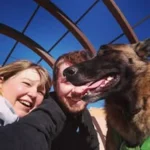If you’ve got a new dog, you’ve got a lot to think about. Your hands are full with training and socialization and vet visits and all that. I’m going to add one more “to do” to your list. Please don’t hate me.
The thing is, this is an extremely important to-do. Especially if you have little kids who would like to keep their fingers. It’ll take you all of five minutes a day and provide peace of mind for years.
You know the old wisdom to leave the damn dog alone when he’s eating? If you are 5 years old, this applies to you. But I’m assuming you’re a grown-up-type person, so I’m going to ask you to kindly ignore that advice.
This exercise is designed to prevent “resource guarding,” which is when a dog becomes protective of his food, growling or snapping when you try to take it. We’re going to teach your dog that people touching his food is OK, and actually a good thing.
But wait, you say. My dog hasn’t shown any signs of resource guarding. Do I still have to do this? Yes! You do. Resource guarding/food aggression can show up later in life. As with most bad habits, it is MUCH easier to prevent the problem now than to try to cure it later.
First of all, you’ll want to feed your dog meals two or three times a day. If you are free-feeding -that is, leaving food out all day for Fido to pick at- it’s time to stop that. Feeding meals makes it clear to Fido that his food comes from YOU, and not that magical bowl on the floor that is somehow always full.
Second, hand feed your dog. I hear you snickering. But seriously, when you feed Fido his breakfast, take a minute to feed him some kibble by hand. This is where the “play with your food” part comes in. Fill the bowl. Before you put it on the floor, have Fido do some tricks. Reward each trick with a piece of food. You only have to do this three or four times, and then you can put the bowl on the floor.
You don’t have to do this part for very long. Just the first couple weeks or so, to establish in Fido’s mind that you are the provider of food.
Third, occasionally give your dog some “gifts” at dinner. Feed your dog his regular food, be it kibble or canned food or whatever. When he’s eating, take his dish away and put something really good in it (piece of boiled chicken, cheese, deli meat, etc), then give it back. This teaches Fido that when people take his dish away, good things happen. Pretty soon, he’ll be eagerly anticipating you taking his dish away!
And that’s it. Pretty easy, yeah? This simple process will go a long way to preventing dog bites in the future. And if you have young kids, this isn’t just a “nice thing to do,” it’s pretty much the most important thing you can do. The last thing you want is for your toddler to escape your supervision, wander up to your eating dog and get bitten in the face.
After you’ve worked on this stuff with your dog and feel pretty confident that the dog is comfortable with it, have your kids do it, too. Just make sure to supervise closely and make sure your child understands the rules.



